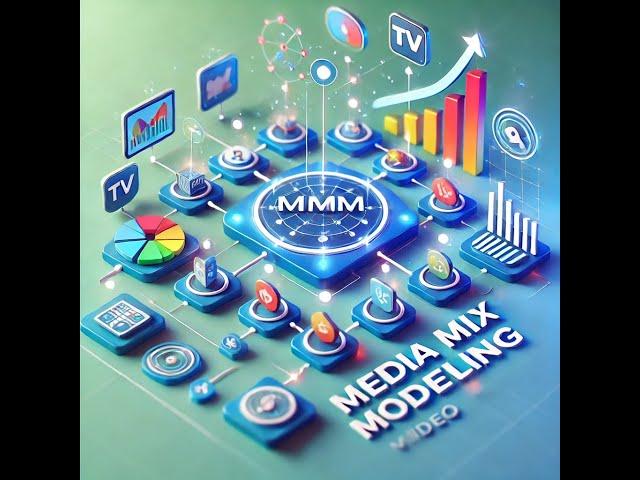
Understanding Media Mix Modeling (MMM) - explained in a minute
What is Media Mix Modeling (MMM)?
Media Mix Modeling (MMM) is a statistical analysis technique used to measure the impact of various marketing channels (such as TV, digital, radio, print, and more) on sales or other business outcomes. It evaluates the contribution of each channel, determines the effectiveness of the spend across channels, and identifies the optimal mix for maximum ROI.
How MMM Works
1. Data Collection: Historical data is gathered, including marketing spend across channels, external factors (e.g., seasonality, economic conditions), and performance metrics (e.g., sales, leads).
2. Modeling: Statistical models (often regression-based) analyze the relationship between inputs (spend) and outputs (sales or other metrics).
3. Insights: The results provide insights into which channels drive results, how much of the outcome is attributable to each channel, and diminishing returns for additional spending.
Why Leverage MMM in Paid Media/Marketing?
1. Holistic Performance Analysis:
MMM considers the combined impact of multiple channels, including offline media (e.g., TV, radio) that aren't easily tracked via digital attribution tools.
2. Quantify ROI:
Understand the return on investment (ROI) for each channel to make data-driven budget allocation decisions.
3. Optimize Media Spend:
Identify underperforming or overspending channels and reallocate resources for better efficiency.
4. Handle Data Privacy Changes:
Unlike digital attribution models, MMM doesn’t rely on user-level tracking, making it robust in a world with increasing privacy restrictions (e.g., third-party cookie deprecation).
5. Adjust for External Factors:
Incorporates variables like seasonality, market trends, or competitor activity, giving a more comprehensive view of performance.
6. Forecasting and Scenario Planning:
Simulate "what if" scenarios to predict the impact of changing budgets or adding new channels to the mix.
Key Considerations for MMM Success
Quality Data: Requires clean, consistent, and comprehensive historical data.
Granularity: More granular data (e.g., weekly spend vs. yearly) provides more actionable insights.
Frequency: Regular updates to the model help capture market dynamics.
Expertise: Building and interpreting MMM requires expertise in statistical modeling and domain knowledge.
Media Mix Modeling (MMM) is a statistical analysis technique used to measure the impact of various marketing channels (such as TV, digital, radio, print, and more) on sales or other business outcomes. It evaluates the contribution of each channel, determines the effectiveness of the spend across channels, and identifies the optimal mix for maximum ROI.
How MMM Works
1. Data Collection: Historical data is gathered, including marketing spend across channels, external factors (e.g., seasonality, economic conditions), and performance metrics (e.g., sales, leads).
2. Modeling: Statistical models (often regression-based) analyze the relationship between inputs (spend) and outputs (sales or other metrics).
3. Insights: The results provide insights into which channels drive results, how much of the outcome is attributable to each channel, and diminishing returns for additional spending.
Why Leverage MMM in Paid Media/Marketing?
1. Holistic Performance Analysis:
MMM considers the combined impact of multiple channels, including offline media (e.g., TV, radio) that aren't easily tracked via digital attribution tools.
2. Quantify ROI:
Understand the return on investment (ROI) for each channel to make data-driven budget allocation decisions.
3. Optimize Media Spend:
Identify underperforming or overspending channels and reallocate resources for better efficiency.
4. Handle Data Privacy Changes:
Unlike digital attribution models, MMM doesn’t rely on user-level tracking, making it robust in a world with increasing privacy restrictions (e.g., third-party cookie deprecation).
5. Adjust for External Factors:
Incorporates variables like seasonality, market trends, or competitor activity, giving a more comprehensive view of performance.
6. Forecasting and Scenario Planning:
Simulate "what if" scenarios to predict the impact of changing budgets or adding new channels to the mix.
Key Considerations for MMM Success
Quality Data: Requires clean, consistent, and comprehensive historical data.
Granularity: More granular data (e.g., weekly spend vs. yearly) provides more actionable insights.
Frequency: Regular updates to the model help capture market dynamics.
Expertise: Building and interpreting MMM requires expertise in statistical modeling and domain knowledge.
Комментарии:
Nandamuri BalaKrishna's VEER SIMHA Hindi Dubbed Full Movie | Sreeleela, Kajal A | South Action Movie
Hindi Dubbed Movie Talkies
The last villages of the Aran Valley
Viajando a nuestro aire
Максим Куст - Озябшее письмо (Калина Красная 2013)
Калина Красная - конкурс песни среди осуждённых
kid travis - Link Up
KidTravisOfficial
What Is Kindness? | #SaySalam | Salam Charity
Salam Charity
Settlement reached in asbestos case
MyNBC5-WPTZ
周星馳 《濟公》粵語中字 高清廣東話 济公 The Mad Monks
HK Good Film











![I'm back and I'm here to stay! [[Gift in the description box]] #WithMe I'm back and I'm here to stay! [[Gift in the description box]] #WithMe](https://ruvideo.cc/img/upload/WVB6MVFUck5rblM.jpg)














